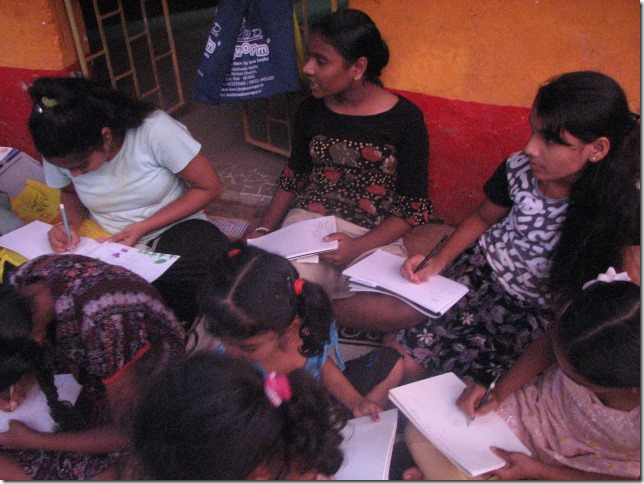I am only just out of a workshop as a trainer where I attempted together with a colleague Usha Mukunda to steer a group towards understanding the long standing rule ‘ Silence’ in the library.
Most of us have grown up with this rule, and have forgotten to question and or reflect on it. Why is silence necessary does it have to be imposed from the outside or does it awaken within when you begin to read and get immersed in another world?
I am still not able to arrive at the best way to communicate this without dismissing long accepted notions. It is hard to challenge deep seated notions unless one can evoke critical thinking around the notion, and this aspect of ‘silence’ is hard to press.
I am reflecting on the idea of silence versus an atmosphere of silence ( listening, reflection, receptiveness). As life often does for me, my learning comes from the work I do on the ground. I had a St. Inez MOP session yesterday evening.
Let me briefly bring St. Inez MOP site to mind. We sit in or outside a small temple space entrusted to us by the community. The community must comprise of around 150 houses with young and old and our numbers on this site have grown from 13 in June to 30 in October. We have Shlok who is 3 years old to Samapada who is 14 and they all participate equitably in the program.
I chose a book called The Bad King Who Became a Good King by Chameli, A.Ramachandran produced by the Vadhera Art Gallery, Delhi. I cannot recall why I had made this choice to include this book in our Story Read Aloud list for October but I know it sprang from the art in the book and the essential theme of good and bad.
Niju, who had read this book at Chimbel last, found it long and a trifle painful. The story line is not complex, the children are very good readers now and complexity of stories must be stepped up. So I decided I needed to apply my mind to a lesson plan here. I prepped, I thought and I reflected on what was essential to this story to keep the spirit of the story alive and enable my listeners to reflect on it.
The story text has plenty of rich vocabulary for ESL and I decided to play with the idea of opposites. We created flaps for the game where the opposites can be also played with in a tactile way. I had a host of interesting questions up my sleeve about good and bad and what not.
We sat outside as it was a dry day and our growing numbers do not make the inside of the temple space conducive to mobility, space and flexibility. We were grooving along and even though we have never ever enforced the idea of silence, a hush ALWAYS descends on the group during story RA. In fact at St. Inez it is not unusual to have a grand parent stand at the side, another stroll by as the book is being read and older boys come and stand at the side to listen to the story.
But today our atmosphere of silence was ruined by a far more exciting event. A police van drew up and every eye and body shifted. I felt the wave of loosing my audience before I realized that the Jeep had driven up. We never recovered our atmosphere thereafter. Not the intriguing art, or the almost total turn around of a bad king or the dramatic appearance of his sword could bring that atmosphere of silence again. We were restless and we were drawn to a more powerful story outside.
Which makes me think about this idea of silence again . While I long recognize it cannot be enforced and no amount of ‘Keep Silent ‘signs or posters will bring in that atmosphere naturally, I am also thinking about the power of a story to keep us silent. Silence seems a necessary condition when we indulge in some activities. I find it most powerfully reflected in art related activities and in reading. These activities consume us so powerfully and in multi sensory ways to ensure that we participate, that a sign or a reminder to be silent is not needed.
If we want to encourage a good atmosphere of silence in the library space, then we are going to be compelled to ensure that the stories we have within the space are so powerful and so compelling that they consume our readers/ listeners and ensure silence. Until then I need to keep talking and reflecting to ensure we can live up to this expectation.









An interesting read – I love the way you present elemental issues that we often do not think about. Rather than ‘Silence’, I think the message during story reading should be ‘Look and listen’ and ‘Think’ because if we are doing these, we are engaged, rather than silently asleep! Talking is wonderful in any language activity but there are times that the teacher needs quiet listening!